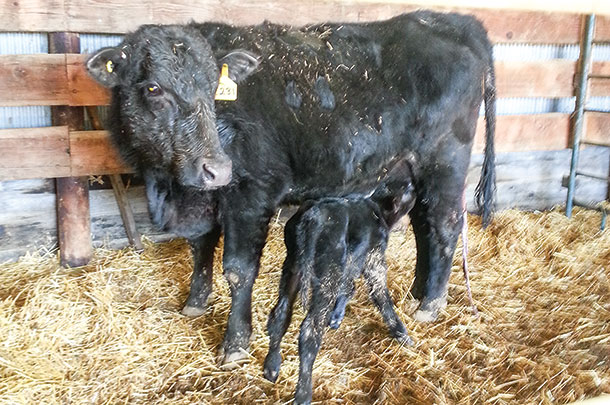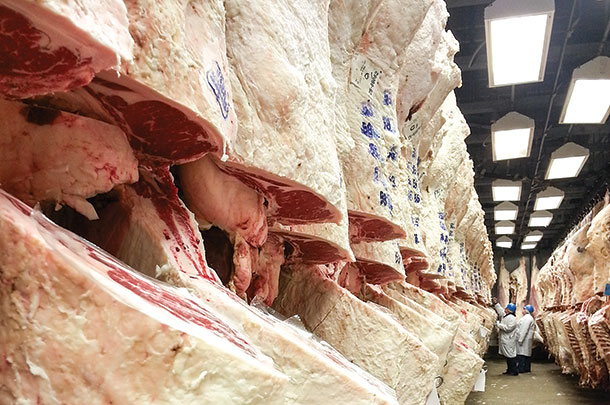Like humans, nutritional intake of mothers during gestation affects the expression of genes and development of physical characteristics.
Don Llewellyn, a regional livestock specialist at Washington State University, has conducted research to better understand fetal programming and what genes are being turned on versus the ones being turned off.
“It gave us ideas we need to start thinking differently about feeding cows,” Llewellyn says. “Not only does what we do with those cows during wintertime feeding programs, it also affects the calf that’s inside of them.”
Even though this research is fairly recent, the idea originated from hard times during World War II. The lengthy war caused food shortages for many people throughout Europe, including pregnant women.
“Women who had very low planes of nutrition had babies who weren’t as healthy, didn’t perform well as adults, and their life expectancy was lower,” says Barry Dunn, the dean of the college of agriculture and biological sciences at South Dakota State University, where similar research is being conducted.
This relates directly to cows and how nutritional deficiencies have an effect on the uterus. The women didn’t receive enough nutrition, and their offspring suffered.
“The negative impacts on a mother during pregnancy are allowing a gene to express itself or not,” Dunn says. “Which actual genes those are is a pretty hard mystery to unravel.”
Yield grades of steers and fertility of heifers have been some of the prevalent areas distorted by maternal nutrition.
Research in the pens and the lab
A research project at the University of Nebraska – Lincoln, aiming to learn more about herd management and factors decreasing production costs, changed when calves were noticeably being impacted. Since then, beef reproductive physiology specialist Rick Funston has been researching fetal programing for 12 years at the university.
“We saw that if we didn’t supplement the cows while grazing winter range, their steers were lighter at harvest, didn’t grade as well, and their heifers had lower fertility as well,” Funston says.

The research is a work in process, and Funston says they are still unsure which genes and mechanisms are being altered. According to Funston, it has been hypothesized that the reproductive tract is affected, which decreases fertility in heifers.
Nebraska-based Darr Feedlot manager John Schroeder has noticed these characteristics in the feedlot, both in observing the cattle and in the end data. After a load of cattle is dropped off, the feedlot keeps track of how well cattle gain and grade. The feedlot then gives ranchers a print-out of the information.
“We make observations here, throughout the feeding period and all the way to the packing plant,” Schroeder says. “The fetal programing aspect definitely explains some of those observations.”
Schroeder recalls a time in 2007 when the winter was tough and cow herds struggled.
“The offspring didn’t perform as well and didn’t gain or grade as well,” Schroeder says. “The heifers that were kept from that year are still being affected eight years later.”
According to Schroeder, the replacement heifers born in 2007 have gone on to produce less-quality calves. Because of the tough winter and cows not receiving adequate supplements, their heifer calves suffered.
“Throughout their lifetime, they didn’t produce cattle that gained as well or graded as well,” Schroeder says.
With this data, Schroeder will go to Funston with different observations and a list of questions. Determined to find some answers, new research is constantly being done at UNL.
“I’ll go to Rick and say, ‘This is what we see, and we don’t know why,’ and they will go and do some research for us,” Schroeder says. “This is just another way to work toward better cattle and better beef products.”
Managing for body condition
According to Funston, a good rule of thumb to keep track of fetus health is to manage the cow’s body condition.
“You don’t see a change in condition from one day to the next, so sometimes those effects are happening and you are not aware of them until they drop a condition score,” Funston says. “So we need to know what the base diet is and if that alone will meet the requirements.”
Funston fed research cattle a pound of 30 percent protein cube and says it dramatically impacts the weight and body condition.
“Evaluate the forage you are feeding and go from there,” Funston says. “If there is enough protein and energy, there is no need for supplementation, but if there is not, we want to supplement enough protein.”
When cattle are delivered to the feedlot, Schroeder can determine which cattle have not been managed appropriately and supplemented with protein and minerals. Schroeder sees changes from year to year, depending on weather, but the data doesn’t lie.
“Sometimes Mother Nature wins those battles even with the best management,” Schroeder says. “But Mother Nature changes, and it’s all about making sure the cattle aren’t too fat but are adequately fed each year.”
The bottom line
Winter feed costs are sometimes the unnecessary weight on a rancher’s shoulders. But good nutrition is worth the price in the long term.
“If you’re going to starve down a pregnant cow for the benefits in the short term, you could change the ability for the animal (the fetus) to achieve its full potential,” Dunn says. “You’ve got to survive the short term to get to the long term.”

According to Dunn, protein is the key to financial success. Protein inside a cow will make the rumen happy and give the cow more energy to take care of the fetus.
“It’s been the magic bullet,” Dunn says. “It’s the advantage for cattle over any other animal species because the rumen of a cow with some protein in it can digest and make good use of what most people would think is really poor-quality feed.”
The hard times every ranch endures may influence the herd negatively for a long period of time. It’s important to keep in mind nutritional intake, provision of protein and how it all affects a fetus.
“That decision to cut feed costs can have a negative impact on the value of the future steer or heifer that is literally in utero,” Dunn says. “This knowledge empowers a rancher to fully understand the impact of their decisions on beef cow management long into the future.” ![]()
Jamie Keyes is a freelance writer based in Utah.
PHOTO 1: Bred heifers in the SDSU Cottonwood Range and Livestock Research Station drylot. Heifers were fed one of two diets (control vs. protein restricted) during gestation.
PHOTO 2: A cow-calf pair involved in the protein restriction study shortly after calving at the SDSU Cottonwood Range and Livestock Research Station.
PHOTO 3: Following calving, offspring from heifers on control vs. protein-restricted diets during gestation were weaned, followed through the feedlot and evaluated for carcass characteristics and meat quality. Photos provided by Amanda Blair.








